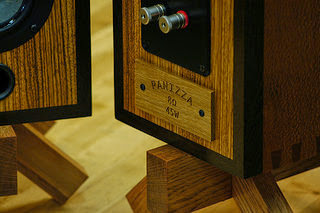 Along with several posts written about the concepts and philosophy behind my design process and workshop layout, this blog has covered the construction of two rather simple projects this year. The first of these was an iPad stand, and the second is a set of candle holders I just completed this past weekend. The two projects pictured here appear different, but yet are almost the same.
Along with several posts written about the concepts and philosophy behind my design process and workshop layout, this blog has covered the construction of two rather simple projects this year. The first of these was an iPad stand, and the second is a set of candle holders I just completed this past weekend. The two projects pictured here appear different, but yet are almost the same.Both designs have four tenoned legs that are glued into the slot mortises of a central block. That block in turn supports a platform that supports an item that needs holding. In one design that item is a candle. In the other that item is an iPad. Both designs appear almost identical from the perspective of the workshop, and so were therefore conceptually supported during their respective build processes quite successfully by the adaptive workcell arrangement around which I built my Minnesota shop.
 There is much more to learn about manufacturing under the principles of Group Technology and the relationship that the broader concept of Design for Manufacturing has on producing a product family. I talked about common design architecture in an earlier post where I described a set of different lamp stands I built that were based on a common product platform architecture. The candle holders and iPad stand are just as much a product family based though on a common build architecture.
There is much more to learn about manufacturing under the principles of Group Technology and the relationship that the broader concept of Design for Manufacturing has on producing a product family. I talked about common design architecture in an earlier post where I described a set of different lamp stands I built that were based on a common product platform architecture. The candle holders and iPad stand are just as much a product family based though on a common build architecture.Update: I just completed building a set of objects to act as prototype fixtures for tungsten filament light bulbs. These are described in a later entry. You can see in the one whose photo I've added here that the concept of a central block with four tenoned legs is used yet again.
 My walk in to work each morning usually takes me through the Mechanical Engineering building at the University of Minnesota. Two useful books on this topic that I found on the free book table there a couple of summers ago are listed below.
My walk in to work each morning usually takes me through the Mechanical Engineering building at the University of Minnesota. Two useful books on this topic that I found on the free book table there a couple of summers ago are listed below.Meyer, M., & Lehnerd, A. (1997). The Power of Product Platforms. New York: The Free Press.
Sanderson, S., & Uzumeri, M. (1997). Managing Product Families. Chicago: Irwin.
I also found the following white paper a good source of recent information on this topic.
Parametric Technologies Corporation. (2012). Achieving Product Diversity with Scale.
The metal candle dishes for the candle holder project were provided by Marlaine Cox Metalworks.























